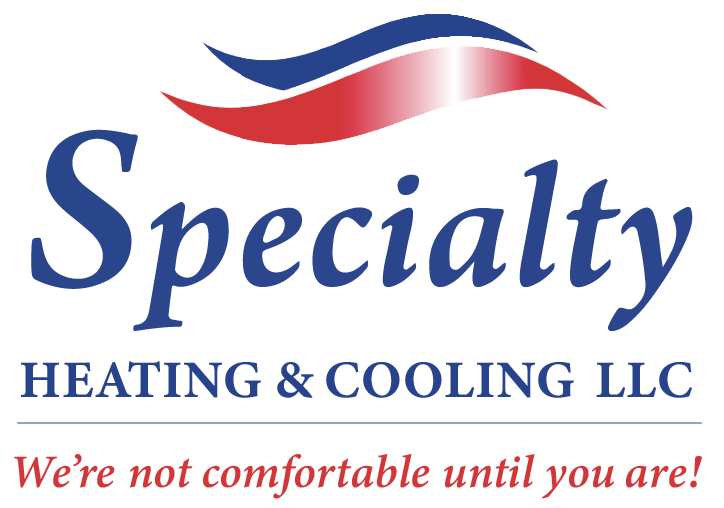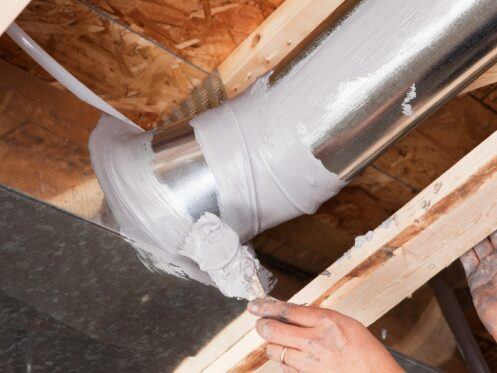Maintaining good indoor air quality is vital for a healthy and comfortable living environment. However, one often-overlooked factor that significantly affects indoor air quality is the condition of the ductwork system. Ductwork problems can lead to a range of issues that compromise the cleanliness and freshness of the air we breathe.
1. Leaking Ducts
Leaky ducts can significantly contribute to poor indoor air quality. When ductwork leaks, air escapes from the system, causing an inefficient distribution of conditioned air throughout the building. These leaks often occur at joints, seams, or connections, allowing unfiltered air to infiltrate the ductwork. As a result, dust, allergens, and pollutants can enter the system and circulate within the indoor environment. In addition to compromising air quality, leaky ducts can lead to energy waste and increased utility bills. The reduced airflow caused by leaks can also disrupt the balance of temperature and humidity in different areas of the building, creating discomfort for occupants. Moreover, leaks in the ductwork can allow for the intrusion of outdoor contaminants such as pollen, exhaust fumes, or even harmful gases.
2. Poor Insulation
Inadequate insulation within ductwork is a prevalent issue that can contribute to diminished indoor air quality. Insufficient insulation allows for temperature fluctuations, compromising the efficiency of heating and cooling systems. Consequently, these temperature imbalances can lead to condensation formation, fostering an environment conducive to mold and mildew growth. These unwelcome guests can release harmful spores into the air, exacerbating allergies and respiratory ailments. Additionally, poor insulation fails to prevent the intrusion of external pollutants, such as dust, pollen, and outdoor contaminants, into the ducts. This infiltration further diminishes the air quality circulating throughout the home or building. Moreover, without proper insulation, energy losses occur as conditioned air escapes through the ductwork, resulting in increased energy consumption and higher utility bills.
3. Inadequate Airflow
Insufficient airflow within a ductwork system can significantly contribute to deteriorating indoor air quality. When air movement is limited, a cascade of negative effects ensues. Restricted airflow diminishes the ventilation capacity, preventing the adequate exchange of stale indoor air with fresh outdoor air. As a result, airborne pollutants, allergens, and volatile organic compounds (VOCs) become trapped, circulating within the living space and accumulating over time. Inadequate airflow can disrupt the balance of temperature and humidity, fostering conditions favorable for mold and mildew growth. These microbial colonies release spores and toxins into the air, which can trigger respiratory issues and allergies in occupants. Poor airflow hampers the distribution of conditioned air, leading to uneven temperature zones and reduced comfort.
4. Contaminant Buildup
Contaminant buildup within ductwork is a significant concern, as it can contribute to a decline in indoor air quality. Over time, contaminants can settle and adhere to the interior surfaces of the ducts, forming a layer of residue. As air passes through the ductwork, it can dislodge and redistribute these accumulated contaminants, leading to their introduction into the indoor environment. Inhaling such particles may trigger allergies and respiratory issues or exacerbate existing health conditions. Moreover, contaminant buildup can negatively impact the efficiency of HVAC systems, causing them to work harder and consume more energy.
5. Mold and Mildew Growth
Mold and mildew, two common fungi, pose significant risks to indoor air quality when they infest ductwork. These microscopic organisms thrive in dark, damp environments and can easily infiltrate ducts through moisture-prone areas. Once inside, they flourish, releasing spores that can become airborne and spread throughout the entire ventilation system. The presence of mold and mildew in ductwork not only compromises the air quality but also contributes to unpleasant odors circulating in the living space. Furthermore, the accumulation of mold and mildew can worsen over time, causing structural damage to the ducts and potentially leading to costly repairs.
6. Pest Infestations
Pest infestations in the ductwork can have detrimental effects on indoor air quality. When pests, such as rodents or insects, invade the duct system, they bring along a host of issues. First and foremost, these unwelcome intruders can contaminate the air with their droppings, urine, and decaying bodies. Furthermore, pests often chew on duct insulation, causing it to deteriorate and release harmful particles into the air. The gnawing can also lead to leaks and gaps in the ductwork, allowing pollutants, allergens, and pests themselves to enter the airflow. As a result, occupants may experience worsened allergies and asthma symptoms or even develop new sensitivities.
7. Dust and Debris Accumulation
Excessive dust and debris accumulation within ductwork is a significant concern as it can contribute to degraded indoor air quality. When airborne particles settle and accumulate, they restrict airflow and contaminate the circulating air. Dust particles, pollen, pet dander, and other allergens find refuge in neglected ducts, creating a breeding ground for respiratory issues. The accumulation not only obstructs airflow but also increases the chances of contaminants being released into the living space, leading to discomfort and potential health problems. As dust and debris continue to accumulate over time, their presence becomes more pronounced, diminishing the air quality and affecting the overall well-being of occupants.
8. Pollutant Infiltration
Pollutant infiltration is a significant ductwork problem that can result in compromised indoor air quality. When pollutants infiltrate the duct system, they become distributed throughout the entire house, leading to health concerns. Pollutants can originate from various sources, including outdoor pollution, cleaning products, and building materials. Over time, they accumulate within the ductwork, increasing the concentration of contaminants in the air supply.
9. Duct Obstructions
Duct obstructions, such as debris or objects lodged within the ductwork, can significantly contribute to poor indoor air quality. These obstructions restrict the flow of air, impeding proper ventilation throughout the space. Consequently, pollutants and allergens remain trapped, circulating repeatedly and exacerbating respiratory issues. Such imbalances can result in uncomfortable temperature variations and uneven distribution of pollutants, affecting both the overall comfort and the air quality within the premises.
10. Aging and Deteriorating Ductwork
As ductwork ages and deteriorates, it becomes increasingly susceptible to contributing to poor indoor air quality. Over time, the structural integrity of the ducts weakens, leading to various issues. Cracks, gaps, and holes emerge, allowing outside contaminants to infiltrate the system. These breaches also facilitate the escape of conditioned air, resulting in energy loss and reduced efficiency. As the ductwork ages further, corrosion and rust may develop, releasing particles and debris into the airflow. These pollutants can circulate throughout the living spaces, leading to respiratory problems and allergies. Moreover, aging ductwork may suffer from loose connections and disconnected joints, leading to air leaks and uneven distribution of air. Such irregular airflow can create stagnant zones where allergens and pollutants accumulate, exacerbating indoor air quality concerns.
Reach Out to Local Experts
At Specialty Heating & Cooling LLC in Portland, Oregon, we provide duct cleaning, duct sealing, and air filters for your home. Our highly skilled team also provides a complete array of heating and cooling equipment installation, maintenance, and repair, plus water heater and generator services. Contact us at Specialty Heating & Cooling LLC today to obtain more information or schedule an appointment.

